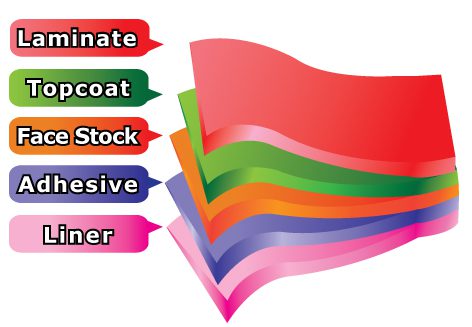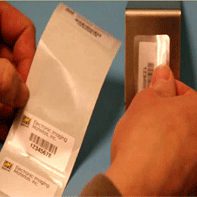Which is better, a gloss laminate or matte laminate? You are getting ready to place a label order but customer service is asking you if you want a matte or gloss label. The base material, no matter whether it is white, clear or silver, will be described as having a matte, semi-gloss or gloss finish. In many cases, when durable labels made of polyester or poly blends are printed with a durable printing ribbon that may be all that you need.
 HOWEVER—you may want to add a protective over laminate to cover the print and protect it against long-term abuse from rubbing or scratching. A laminate, aka film overlay, provides a waterproof layer of protection and is often a good barrier against harsh chemicals and solvents. It’s important to understand though, that a clear overlay can totally change the look of your label.
HOWEVER—you may want to add a protective over laminate to cover the print and protect it against long-term abuse from rubbing or scratching. A laminate, aka film overlay, provides a waterproof layer of protection and is often a good barrier against harsh chemicals and solvents. It’s important to understand though, that a clear overlay can totally change the look of your label.
• Putting a matte laminate over a glossy label stock will dull it down and sometimes that is exactly what you need—for instance, to easily scan a barcode printed on a metallic polyester, a non-glossy finish is best. A laminate with a duller satin or frosty finish cuts down on glare and the reflectivity that could disrupt a scanner. Generally, a semi-gloss or matte finish is more subtle, looks sharper and makes colors appear deeper and brighter. A matte laminate will often let you handwrite on your label too, as it tends to hold ink better than an ultra-smooth material.
• If you put a glossy, crystal-clear laminate over a matte label, it can draw more attention as light reflects off the label. It looks rich and exciting and makes a dull surface pop! Gloss laminates are both popular and generally less expensive. There are even gloss laminates made specifically for thermal transfer printing; their smooth finish is designed to provide high-quality print results. For UV light resistance, we also have a gloss laminate made just for long-term outdoor exposure.
The container or surface to which you are applying your labels may also help determine what you need for a laminate or label material. As an example, you may want a no-label look on a clear plastic bottle to give it an elegant appearance. If the bottle has a frosted finish, then a matte laminate is probably a better choice.
But you are not limited to over-laminates. We can add a varnish over inks to protect your label’s printed information, or to make a label thermal transfer printable; varnishes are best used for indoor applications where labels won’t be exposed to a lot of moisture. We have both water-based varnishes and ones that dry with exposure to UV radiation; they tend to produce a semi-gloss or satin finish. A UV or ultraviolet varnish will intensify colors, and add clarity and definition to printed images, plus it offers good abrasion resistance. Another important feature of varnishes is that they are less expensive than over laminates which may be important if you need a lot of labels.
The bottom line, before you make your final label decision, you need to think about how you want your label to LOOK and what it must handle for abuse. It may involve more than picking the right adhesive and what you are printing on your label. It’s important to consider the label’s surface and what you need to make your label last the longest.
Need help? The Label Experts are always happy to help with these important technical details!




